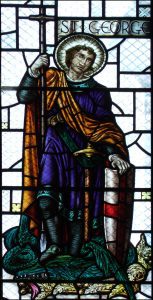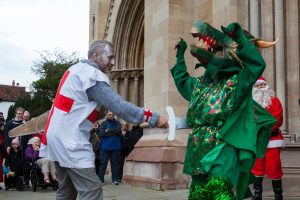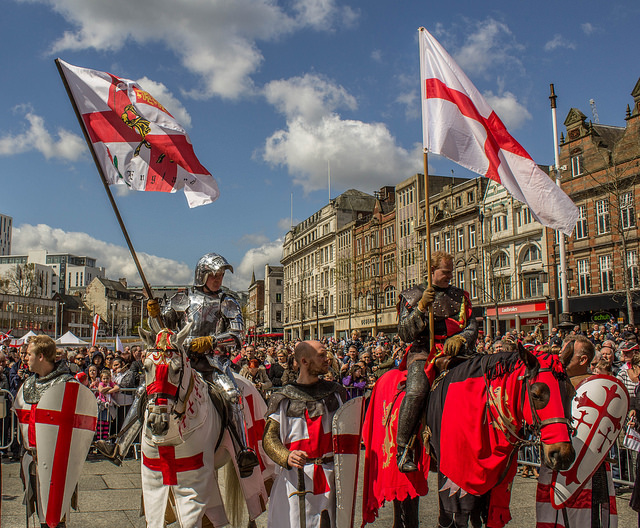23rd April is St George’s Day, but who exactly was England’s patron saint?
You may know that his cross – red on a white background – forms our national flag, that he is often shown mounted on a horse and that he has something to do with dragons.
But what connection does he have with England and why is he a somewhat neglected national saint, inspiring less celebration than St Patrick in Ireland and even Scotland’s St Andrew?
Who was St George?


St George was a Roman soldier who was born in Cappadocia, in what is now Turkey, in the reign of Emperor Diocletian. Diocletian began an official persecution of Christians, but this didn’t stop George from publicly declaring his faith. Like many saints from that time, he was tortured in numerous and terrible ways before being put to death, in George’s case by beheading.
According to legend, he was martyred in the year 303 on 23rd April, which subsequently became his official day.
There is a large shrine to St George in Lod, now in Israel. As well as being the patron saint of England, St George is also the patron saint of Portugal, Catalonia and Ethiopia, as well as being the official saint of the cities of Genoa, Moscow and Beirut.
So what’s the link between St George and the Dragon?
The image of St George killing the dragon – often from horseback with a lance – is widespread throughout the Christian world. But the original legend of St George makes no mention of a dragon whatsoever.
George seems to have acquired his dragon in the 13th century, something that proved to be a massive boost for the saint’s popularity. The dragon gave George a colourful backstory and widely recognised trademark, and it fit well with ideas of knightly chivalry popular at the time.

In the most famous dragon story, popularised in the medieval book The Golden Legend, there was a plague-infested dragon who lived in a lake near a town in Libya.
To stop the dragon eating the townspeople, the residents gave it two sheep a day. But when they ran out of sheep, the town’s king invented a lottery system that chose local children to feed to the beast.
The day came when the king’s own daughter was selected and, as she was being taken to the lake, St George rode by. St George said he would fight the dragon, but only if the townsfolk agreed to become Christians.
George succeeded in killing the dragon and saving the princess, and the inhabitants of the town were baptised.
This type of story – in which a hero slays a dragon, monster or giant and rescues a princess – can be found in folktales, myths and religions in many parts of the world.
So why is St George the patron saint of England?
The historical St George almost certainly never visited England and most of the legends of St George and the dragon do not take place in this country.
St George’s cult was introduced to England by soldiers returning from the Crusades, who had been struck by his popularity among Christians in the Middle East. They were also attracted by his reputation as a warrior saint and by the legend that he had appeared in the sky to spur on Christian troops at the Siege of Antioch in 1098.
St George soon became popular in England. In 1222, the Synod of Oxford officially recognised St George’s Day and by the mid-14th century George had replaced King Edward the Confessor as England’s patron saint.
There is one legend that links St George to England. In Oxfordshire, there is a small hill – named Dragon Hill – on which St George supposedly slew a dragon. On the hill’s top, there is a barren patch of ground on which no grass will grow. This is where the dragon’s noxious blood is said to have fallen.
How did people celebrate St George’s Day in the past?
Throughout England voluntary organisations called fraternities were established, dedicated to St George. These fraternities provided churches with images and statues of the saint and some of the wealthier ones built whole chapels in honour of him.
In April, the statues of St George were carried through the streets in processions. These processions also often featured a dragon. These could be small models mounted on poles, with snapping jaws worked by pieces of string. But more elaborate processions could feature large wicker-work dragons which were pushed along on wheels or had several men concealed inside.
The Reformation put an end to these colourful celebrations. Protestant reformers discouraged religious processions, demolished statues of saints and painted over their images. Since this time, St George’s Day has been more or less neglected in the English calendar though there is evidence that the celebration of St George lingered on in some folk customs, such as Easter plays.


Do people do much to celebrate St George nowadays?
Over the years, there have been attempts to revive St George’s Day as a celebration of Englishness. The Royal Society of St George – an organisation dedicated to promoting English culture, including the celebration of St George’s Day – was founded in 1894.
The founder of the Scouts, Robert Baden Powell, made St George the patron saint of the scouting movement and some scout groups hold a parade on the Sunday closest to St George’s Day.
Since the late 1990s, the St George’s Cross flag has become more popular, especially when sporting events are taking place. This can be seen as a reaction to Scottish and Welsh devolution, which raised questions about what it means to be English and how Englishness differs from a more general British identity.
There have been calls – supported by English Heritage and The Royal Society of St George – to make St George’s Day a public holiday in England. In 2011, a petition attempted to get Parliament to debate this idea, but it only got 4,266 signatures, a long way short of the 100,000 that would have forced Parliament to hold such a debate.
In London in 2002, there were protests at the then mayor Ken Livingstone spending £100,0000 on St Patrick’s Day celebrations while ignoring St George’s Day. This led to the establishment of an annual St George’s celebration in Covent Garden featuring Punch and Judy shows, folk music and English folk dancing.
Since 2010, there has been an annual Feast of St George centred on Trafalgar Square and organised by the Mayor of London. St George’s events have also started popping up in other towns, pointing to the possibility of a revival in the popularity of the saint.
The drinks industry has for a number of years been encouraging people to go out drinking on St George’s Day in a similar way to how St Patrick’s Day is celebrated and pubs are often festooned with St George’s flags.
(Featured image by Ian Emerson)


























